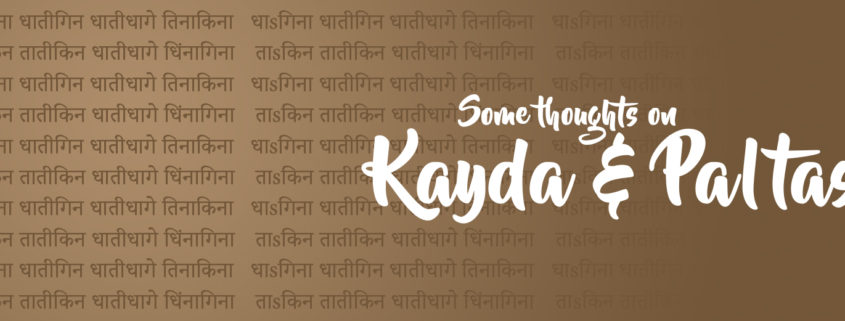
Whenever my mind is free, I think primarily about two things: experiences with my gurūs and experiences with my students. The truth is that what I learned from my gurūs was “half” learning. I fully learned what they had taught when I, in turn, taught it to my students. I may have taught a beginner kāydā like Dhā TeṬe, Dhā TeṬe more than a thousand times. This means I have learned Dhā TeṬe more than a thousand times. It is only through teaching the kāydā that I have truly digested the kāydā. The more I taught the kāydā, the more familiar with and attached to the composition I became. It has gone so deep in my soul that whenever I teach it, it comes out with a new form (palṭās or design). Every composition has its own mood and identity. To maintain the basics elements of the composition and create palṭās of the composition is the greatest fun.
Let me talk about Dhā TeṬe today.
Dhā TeṬe Dhā TeṬe Dhā Dhā TeṬe DhāGe Tinā Kinā/
Tā TeṬe Tā TeṬe Dhā Dhā TeṬe DhāGe Dhinā Genā
This composition is one of the famous compositions of Delhi Gharānā. This composition has existed for over 200 years in the field of music. In Hindustāni classical vocal, we have rāgas. We divide rāgas in three main scales: Oḍav-jāti, rāgas with five notes; Shāḍav-jāti, rāgas with six notes; and sampūrṇa-jāti, rāgas with all seven notes. In tablā compositions, they have maintained this concept. We, too, have compositions of five notes, six notes and seven notes. Dhā TeṬe is a composition of five notes – Dhā, TeṬe, DhāGe, Tinā, Kinā. These are the five major notes of this composition.
As I mentioned, this is a composition of Delhi Gharānā. The use of only the first two fingers is permitted. Almost all the compositions of Delhi Gharānā are played solely with the first two fingers. That is why Delhi Gharānā is also known as Do uṅgalīyo Kā Bāz, the Gharānā of Two Fingers. The most important thing in a kāydā is its palṭās or variations. Without disturbing the main composition’s form, by using the small changes, we create palṭās.
There is an interesting combination between technique and creativity. You can make hundreds of palṭās of each kāydā, but in performance, generally we play 7 to 15 palṭās of each composition (according to time limit and the nature of performance). The challenge is that every palṭā must have its own identity and we shouldn’t play palṭās that seem repetitive or very similar to others. With this challenge in mind, one has to take into consideration the balance between the bāyāṅ and dāyāṅ, the rules of the gharānā, and aesthetic values. From their variety of palṭās, we can assess the understanding and strength of the performer.

